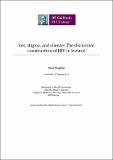| dc.contributor.advisor | Power, Martin | |
| dc.contributor.advisor | Sixsmith, Jane | |
| dc.contributor.author | Vaughan, Elena | |
| dc.date.accessioned | 2019-02-25T12:20:04Z | |
| dc.date.issued | 2019-01-11 | |
| dc.identifier.uri | http://hdl.handle.net/10379/14994 | |
| dc.description.abstract | Improvements to treatment mean that HIV is now a chronic, manageable illness. People living with HIV (PLHIV) have a life expectancy on a par with HIV negative individuals, and are non-infectious once the treatment goal of undetectable viral load (UVL) has been reached. In spite of such improvements HIV-related stigma continues to negatively impact the lives of PLHIV in complex ways and furthermore acts as a barrier to treatment and prevention efforts. In Ireland, the rate of new HIV diagnoses has grown considerably in the past few years, with the highest ever number of new diagnoses recorded in 2016 (HPSC, 2017).
This research examines the phenomenon of HIV-related stigma in the Irish context. Two studies were conducted. The first study explored the discursive construction of HIV in the Irish print media. 103 news articles printed in national newspapers over a ten year period were analysed using Critical Discourse Analysis (CDA), Limited Content Analysis and Technique Triangulation. The second study explored the experiences of stigma of 14 individuals with HIV from diverse cohorts. The interviews were analysed using Directed Content Analysis, utilising a conceptual framework developed as part of the review of the literature. This framework drew on existing conceptual frameworks for stigma, underpinned by readings of Bourdieu (1977) and Foucault (1984).
The findings indicate that HIV-related stigma is keenly bound up with discursive constructions of HIV that both shape and reflect deeply embedded cultural notions of sex, morality and health and illness. Analysis showed how such constructions mediate the embodied and enacted stigma experiences of PLHIV and how symbolic and structural violence are implicated in this process, working in tandem to negatively affect the health and well-being of those disproportionately affected by HIV. This study has implications for policy and practice and may be useful for informing stigma interventions going forward. | en_IE |
| dc.publisher | NUI Galway | |
| dc.rights | Attribution-NonCommercial-NoDerivs 3.0 Ireland | |
| dc.rights.uri | https://creativecommons.org/licenses/by-nc-nd/3.0/ie/ | |
| dc.subject | HIV | en_IE |
| dc.subject | Stigma | en_IE |
| dc.subject | Health Promotion | en_IE |
| dc.subject | AIDS | en_IE |
| dc.subject | Media | en_IE |
| dc.subject | Critical Discourse Analysis | en_IE |
| dc.subject | Qualitative Reseaarch | en_IE |
| dc.subject | Sexual Health | en_IE |
| dc.subject | Symbolic Violence | en_IE |
| dc.subject | Structural Violence | en_IE |
| dc.subject | Habitus | en_IE |
| dc.subject | Health science | en_IE |
| dc.subject | Health promotion | en_IE |
| dc.title | Sex, stigma and silence: the discursive construction of HIV in Ireland | en_IE |
| dc.type | Thesis | en |
| dc.local.note | This thesis examines representations of HIV in the print media and their relationship to the stigma experienced by people living with HIV in Ireland. The research proposes a novel conceptualisation of stigma involving processes of symbolic and structural violence which negatively impact on public health and deepen social inequality. | en_IE |
| dc.description.embargo | 2019-08-15 | |
| dc.local.final | Yes | en_IE |
| nui.item.downloads | 773 | |


